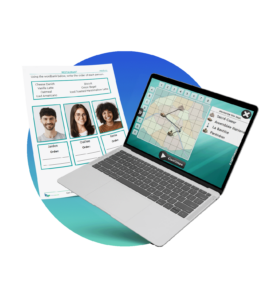
All of the different forms of attention are essential to our daily lives and well-being, with each one requiring rigorous training. Using computerized tools, healthcare providers can help clients develop strategies that can improve their attention span. HappyNeuron Pro happens to be a tool that many healthcare providers use to do so. Because of the diversity of the exercises and difficulty levels, you’ll soon be able to help your clients improve their attention span and ability to focus!
We’ve all gone through times when we haven’t been able to focus on the task at hand or have found ourselves drifting off and daydreaming while something else was going on. But why does this happen? What are “attention” and “focus” exactly, and how do they work? How can we improve them?
The terms attention and focus are often used interchangeably, but do they refer to the same thing? Surprisingly, the answer is no. Although attention and focus are interdependent and complementary to one another, the mechanics of each process are significantly different.
Attention relies on the sensory receptors in our brain that process hearing, sight, smell, touch, and taste. Attention corresponds to the way the mind processes an external event (a sound, image, smell) or an internal event (a thought or feeling) and then sustains this event at a certain level of awareness. For example, when you see and hear someone on a stage singing a song that reminds you of your childhood, you pay attention.
Focus, on the other hand, is a process that requires a higher degree of awareness. Its role is to ignore non-relevant data, to block out the unnecessary background noise of someone next to you unwrapping a piece of candy or of the heads of the people in front of you. It can therefore drastically reduce our field of attention for a given situation. Focusing is a willful act, one that maintains attention at its highest level. The processes are interdependent: the more focused you are on something, the less aware you are of what is going on around you; conversely, if you are very aware of everything that is going on around you, you will find it very difficult to focus on something in particular.
Attention is a complex cognitive function and major area of interest in neuropsychology and cognitive psychology… and for good reason. It is absolutely necessary to the correct cognitive functioning of all individuals. As we will describe below, there are several components to the phenomenon of attention.
A certain amount of information from our environment (sounds, smells, etc.) reaches our sensory receptors at all times, but it is impossible to process all this information in detail. The information is instead subject to a competitive process. Selective or focused attention chooses which information to prioritize according to its relevance to the context and situation at hand. Selective attention enables you to focus on an item while mentally disregarding all other non-relevant information, without the need to remove the distractions from the environment. Selective attention is therefore absolutely essential to our actions and global cognitive processes.
For instance, selective attention enables our visual system to not only automatically process and analyze a visual scene, but also makes us truly aware of our surroundings. Selective attention can then be physically perceived by gaze orientation, the physical orientation of the head, and sometimes the upper body towards a relevant piece of information.
Well-tuned selective attention gives us the ability to disregard and resist interference from irrelevant information. For those who are easily distracted, attention becomes sidetracked by irrelevant items. In order to stay focused, those with deficits need to reduce the number of environmental stimuli that can cause a distraction – for instance, they may need to find a quiet place in order to listen to something carefully.
Exercises involving finding the odd item out of a series, or on the contrary, finding a target item among distractions can be used to assess this type of attention.
The ability to divide your attention and share it between several activities is crucial to the simultaneous achievement of multiple tasks. It requires a logical distribution of your attention resources based on the requirements of each activity.
Routine situations in which you perform two tasks at the same time require very few attention resources (e.g. having a conversation while driving home). This is also true for activities in which you have a high level of expertise. But when you are faced with unusual situations (or activities for which you have little expertise), such as driving to an unfamiliar location while talking to a passenger, the planning and allocation of attention resources becomes more challenging. Similarly, your use of attention resources increases with the number of items you need to focus on.
Sustained attention is implied when you have to maintain a certain level of attention continuously over a longer time span. It is particularly solicited by activities that involve a regular and intense flow of information, such as driving.
Vigilance differs from sustained attention in that it does not imply a continuous active process, but rather simply maintaining awareness at a sufficient level as to be able to react to a few events that may occur at random during a monotonous activity. Fishing is an excellent example: you may wait for hours on end, but you still need to react quickly and adequately when the fish bites.
Attention is not only strongly dependent on what is happening in your environment (external factors) but also on what is happening inside you: your mood, motivation, priorities, interests… Different forms of alertness enable you to manage these factors.
The capacity to easily engage, release, and then re-engage your attention is one of its inherent qualities; it is needed when you have to process information alternatively, skipping from one information source to another. Learning to skillfully control one’s attention is, therefore, a great asset.
For more information about the causes and terminology of Attention Disorders please see Part three of our series on attention: Attention Disorders
Click here to get a free trial! We also provide free worksheets which you can use with our digital tool to supplement the material we provide. Join the many activity directors and clinical providers who use HappyNeuron Pro to help their clients today!

Pulling from our decades of experience in Cognitive Therapeutics, we aim to help you enrich your practice through the use of digital and paper tools.
Pricing + Offers


© 2023 HappyNeuron is a Product of Humans Matter